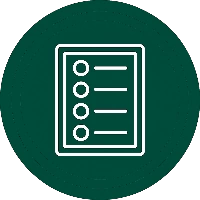Your business data holds the key to the future. While standard reports tell you what happened, a truly effective strategy depends on knowing what will happen next. Microsoft Power BI predictive analytics makes this easy. We’ll provide you with a clear, practical overview of how you can use predictive models in Power BI to make smarter, forward-looking decisions.
Can Power BI Be Used for Predictive Analysis?
Yes. Power BI is a powerful tool for predictive analysis. It offers multiple ways to forecast future outcomes directly within its interface, transforming your dashboards from historical records into forward-looking guides.
This capability allows you to move beyond simple historical reporting. Instead of just analyzing past performance, you can use data forecasting to anticipate trends, identify opportunities, and mitigate risks before they happen.
The core value of performing predictive analysis in Power BI is its ability to embed these predictions right alongside your key business metrics, making them accessible to decision-makers across your organization.
How Do You Create a Predictive Model in Power BI?
You create and implement a predictive model in Power BI by choosing one of three primary methods. The right approach depends on your business needs, your team’s technical skills, and how complex the prediction needs to be.
Your options range from a simple, built-in tool for quick forecasts to full data integration with powerful machine learning platforms. We’ll cover each implementation method so you can select the best fit for your project and your data models.
Method 1: Using Power BI’s Built-in Forecasting for Quick Insights
The simplest way to start is with Power BI’s native forecasting feature. This built-in model is designed specifically for time series forecasting—like predicting the next few months of sales based on the last few years of data.
The default forecasting model in Power BI is Exponential Smoothing (ETS), a standard statistical method for finding patterns in data over time.
You can add a forecast to any line chart in minutes:
- Create a line chart that has a continuous date or time value on the x-axis.
- Select the chart and go to the Analytics panel (the magnifying glass icon).
- Find the “Forecast” option and click “Add”.
- Set the forecast length and confidence interval to see the prediction on your chart.
Method 2: Integrating R and Python for Custom Models
For predictions that go beyond simple time series, you can use R or Python scripts directly within Power Query. This approach gives you the freedom to build your own custom models.
This method is ideal for analysts with some data science skills. It opens the door to more advanced predictive analytics using Power BI, such as:
- Regression models to predict exact numbers, like future product sales.
- Classification models to predict a category, such as which customers are likely to churn.
- Clustering models to group similar items, like segmenting customers based on behavior.
Method 3: Connecting Azure Machine Learning for Enterprise-Grade Power
When you need the most powerful and scalable solution, you connect Power BI to Azure Machine Learning (Azure ML). This is the best option for handling large datasets and complex business problems.With this method, data scientists build and train advanced models in Azure ML, often using AutoML to speed up the process.
Once the model is ready, it can be connected to Power BI dataflows. The main benefit is that business users get to use the output of these very powerful, scalable models in their reports without touching any code. This is the top choice for enterprise-grade predictions.
| Feature | Built-in Forecasting | R / Python Scripts | Azure Machine Learning |
|---|---|---|---|
| Best For | Quick trend analysis & simple forecasts | Custom analysis & specific business logic | Enterprise-scale predictions & critical operations |
| Technical Skill | Basic (Any Power BI user) | Intermediate (Requires R/Python knowledge) | Advanced (Requires data science & Azure skills) |
| Model Types | Time Series Only (Exponential Smoothing) | Regression, Classification, Clustering | All types, including AutoML and deep learning |
| Scalability | Low (Best for smaller datasets) | Medium (Limited by gateways/performance) | High (Built for production-level data) |
Ready to Build Powerful Predictive Models in Power BI?
We can help you choose the right method for your business, prepare your data for analysis, and integrate reliable forecasts directly into your reports.
Let’s build your predictive analytics strategy together.

Let’s build your predictive analytics strategy together.

What Are the Limitations of Predictive Analytics in Power BI?
While Power BI is a great tool for predictions, it is important to know its limitations. Understanding these helps you choose the right approach and plan your project for success.
- Limited Built-in Forecasting: The standard forecasting tool is fast and easy, but it only uses one algorithm (Exponential Smoothing) and only works for time-series data. It cannot handle more complex business questions.
- R/Python Performance: Integrating R and Python scripts can cause scalability issues. They may run slowly with very large datasets, and managing personal gateways for scheduled refreshes can become complicated.
- Complex Data Preparation: The accuracy of any prediction depends on high data quality. Preparing your data for a model is often the hardest part. It requires strong skills in Power Query and DAX to clean and structure the information correctly.
- Need for Real Expertise: Power BI makes using predictions simple, but creating them is not. Building and testing a model to get high model accuracy, especially with Azure Machine Learning, requires real data science knowledge.
Our Data Consulting Services You Might Find Interesting
What Are the Key Business Use Cases for Predictive Analytics in Power BI?
You can use predictive analytics to solve specific, high-value business problems.
Sales Forecasting
You can predict future revenue with much greater accuracy than a simple guess. This helps with budgeting, resource planning, and setting realistic targets.
Customer Churn Prediction
By analyzing customer behavior, you can identify who is at risk of leaving. This allows your marketing and sales teams to act before you lose valuable customers.
Inventory & Operations Management
Go beyond basic stock counts with effective demand planning. Forecasting future demand helps you optimize inventory levels, reduce waste, and avoid supply chain disruptions.
Fraud Detection
You can use anomaly detection models to automatically flag suspicious or unusual transactions in your financial data, helping to catch fraud earlier.
Ready to See What’s Next in Your Data?
Power BI gives you the tools to get started with predictive analytics. But turning those tools into predictions you can actually trust requires more than a few clicks. Getting the data right and building an accurate model are often the hardest parts of the process.
Don’t let the complex steps stop you. The experts at Multishoring build and connect the right predictive models for your Power BI environment. Contact us to learn how you can make decisions based on what’s likely to happen, not just on what already has.











